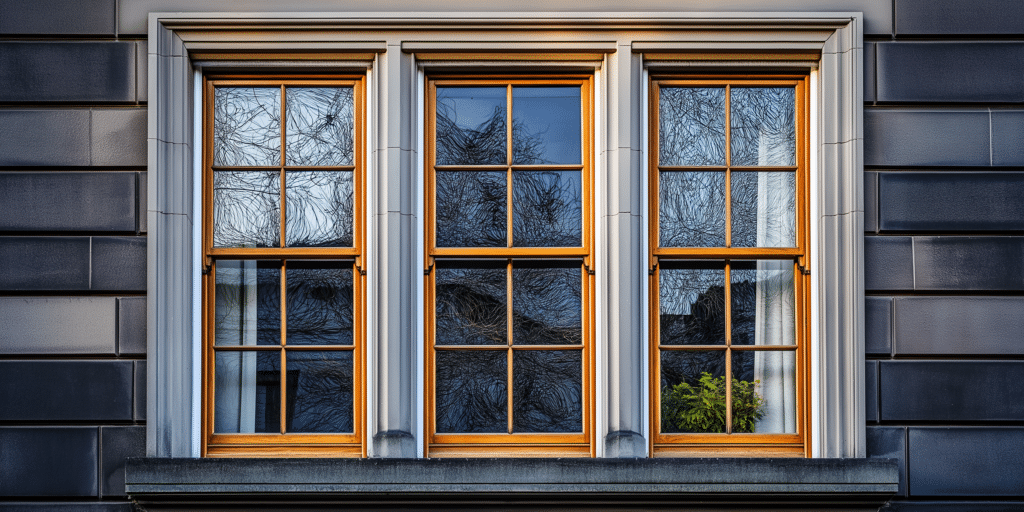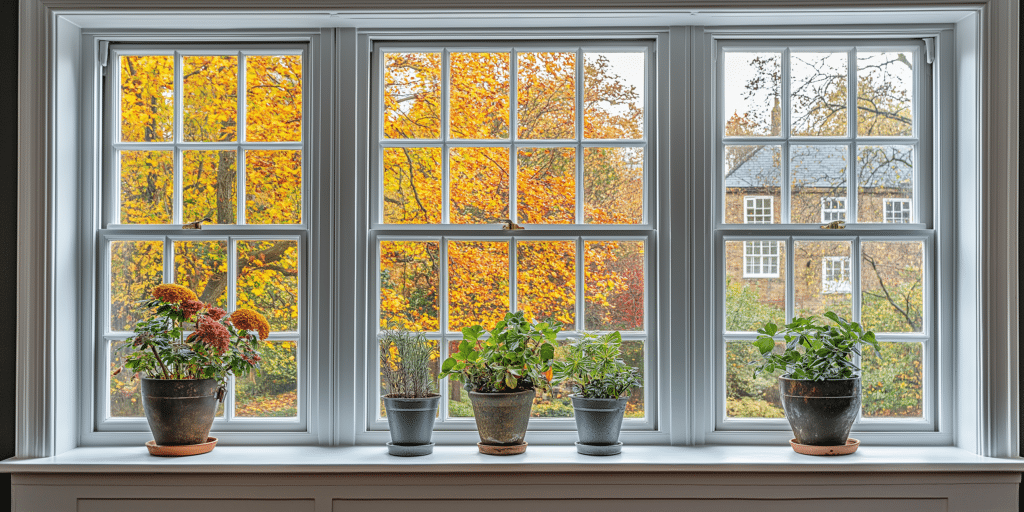Understanding Sash Window Sills and Their Importance

A sash window sill plays a pivotal role in window functionality and aesthetics, providing foundational support for both the sash window frame and the glazing system. But what makes a well-crafted sill so essential? By securing the window structure and sealing off external elements, the sill significantly contributes to thermal insulation and moisture resistance. With the right choice, a quality sill prevents water ingress, curbs condensation, and reduces potential damage to the property’s timber, plaster, and paint finishes.
Experienced installers suggest proper sealing can reduce heat loss by up to 30%, enhancing energy efficiency and stabilising interior temperatures. This makes high-quality materials and precision installation especially important, particularly in heritage and conservation areas where historical accuracy must be maintained.
Types of Sash Window Sills
- Timber Sills: These sills offer traditional appeal with natural insulating properties, making them ideal for period properties. However, regular sealing and painting are necessary to prevent wood rot and maintain appearance. Experts advise choosing high-durability woods such as oak, as their resilience to moisture extends the sill’s lifespan.
- uPVC Sills: Highly resistant to weathering, requiring minimal maintenance, and offering a sleek, modern look, uPVC sills are commonly chosen for newer builds. With a typical cost advantage, uPVC is also popular for home retrofits aiming to improve energy efficiency.
- Aluminium Sills: These provide superior durability and strength, particularly suited for larger sash windows due to their rigidity and resilience against warping. Many experts recommend aluminium in coastal climates due to its resistance to corrosion, a common issue with timber in these areas.
Each material serves unique environmental and architectural needs, so understanding your home’s climate and aesthetic requirements is crucial to making an informed decision. Sash window authorities frequently recommend choosing a sill material based on climate and historical significance, especially when working with period homes.
Preparing for Sash Window Sill Installation: Tools and Materials
Thorough preparation is essential to ensure a successful installation. Gather high-quality tools and materials specific to sash window sill installations for optimal results.
Essential Tools
- Spirit level: Ensures horizontal alignment of the sill to prevent draughts and optimise sash movement.
- Sash saw and wood chisel are indispensable for trimming timber to precise dimensions, especially with irregular wall edges.
- Weatherproof sealant: Silicone-based or polyurethane-based sealant forms a durable barrier against water infiltration and heat loss, which, according to industry studies, can improve overall thermal performance by up to 20%.
Choosing Materials for Specific Climates
In coastal or humid areas, choose materials like aluminium that resist moisture damage, and in colder climates, select timber with enhanced insulation properties. Precision in measurements and surface preparation, such as sanding, ensures the sill fits seamlessly, preventing gaps and contributing to a durable installation. Sash window professionals highlight the importance of exact alignment, as misalignments can lead to draughts and compromise insulation, especially in period properties.
Choosing the Right Material for Sash Window Sills

Selecting the right material is a fundamental step in ensuring a long-lasting installation. Here’s how each material affects durability, insulation, and maintenance.
Factors to Consider
- Timber: Known for its aesthetic appeal, timber complements traditional and heritage properties but requires regular varnishing or painting. Hardwoods like oak and mahogany offer greater resilience against moisture than softwoods, providing superior durability with regular maintenance.
- uPVC: Offering excellent weather resistance and minimal upkeep, uPVC sills are rot-proof and resistant to UV rays. However, they may lack the historical authenticity desired in older properties.
- Aluminium: With a high strength-to-weight ratio, aluminium sills are ideal for larger or wider window frames. They offer robust support without warping, and powder-coated finishes add extra resilience against environmental elements.
For those seeking sustainability, look for FSC-certified timber or recycled uPVC options, ensuring environmental responsibility without compromising performance. Installers recommend recycled uPVC and certified wood to enhance the eco-credentials of sash window projects.
Step-by-Step Sash Window Sill Installation Process
Following each step of the installation process is vital for an effective and efficient installation.
1. Measuring and Cutting
Begin with precise measurements, accounting for wall irregularities. Use a spirit level to ensure accuracy and a sash saw to achieve the exact sill width. Double-check measurements, as even slight discrepancies can lead to misalignment or drafts. Many experts suggest investing in high-quality measuring tools for this stage to ensure precision.
2. Surface Preparation
Clean the area where the sill will be installed, removing debris and ensuring a smooth base. Sanding is often necessary for uneven surfaces to provide the best fit.
3. Securing the Sill
Apply a thick, even layer of weatherproof sealant along the base of the sill. Press the sill firmly into position, using the spirit level to verify alignment. Proper sealing prevents moisture ingress, enhancing the window’s insulation.
4. Final Inspection
Check alignment, seal integrity, and structural support to properly seat the sill. This final check prevents sagging or misalignment, which can lead to long-term issues like draughts or leaks.
Securing and Sealing for Weatherproofing
A critical component of sill installation is ensuring it is sealed and weatherproofed. Industry professionals estimate that sealing alone can improve a window’s thermal efficiency by approximately 20-30%, especially in older properties where draught-proofing is essential for energy savings.
Importance of Sealing
Proper sealing prevents water and air infiltration, improving energy efficiency by maintaining consistent indoor temperatures. Silicone-based sealants offer excellent flexibility and adherence, which is ideal for timber and uPVC sills, while polyurethane options are better suited to metal.
Signs of Poor Sealing
Look out for condensation build-up, cold spots near windows, or peeling paint on interior surfaces—these can indicate insufficient sealing. Immediate reapplication of sealant, especially in high-exposure areas, prevents issues like wood rot and mould growth, protecting both the sill and internal window components.
Installing Sill Supports and Frame Anchors

Sill supports distribute the window’s weight, preventing undue strain on the sash frame, which could otherwise cause bowing or sagging. Supports should be positioned at equal intervals to distribute pressure, particularly with larger sills or heavier timber frames.
Choosing the Right Anchors
For hardwood sills, experts advise choosing metal anchors with a rust-resistant coating, while uPVC sills benefit from plastic fasteners to prevent cracking. Ensure anchors are installed firmly but avoid over-tightening to prevent warping.
An expert installer explains, “Anchors need to be well-calibrated to avoid excessive strain on the frame, ensuring the longevity and structural integrity of the sash window.
Final Adjustments and Alignment Checks
Ensuring the final alignment of the sash window sill is critical to maintaining both functionality and aesthetic appeal. Even minor misalignment can cause significant issues, including draughts, increased wear on the sash components, and possible water ingress.
Importance of Alignment
Proper alignment ensures smooth operation and prevents future repairs. According to heritage conservation experts, a misaligned sill can reduce the lifespan of sash windows by up to 25% due to increased friction and weather exposure. To mitigate these risks, experts recommend checking alignment with a spirit level and adjusting as needed to ensure the sill fits perfectly against the frame. Adding shims or using additional layers of sealant can help fill any small gaps that may affect the window’s energy efficiency.
Professionals often note that precise alignment also improves the window’s insulation properties, an especially important factor for those in colder climates seeking to enhance thermal efficiency. A well-aligned sill not only improves the appearance but also plays a crucial role in reducing draughts, a point echoed by window specialists who emphasise the role of proper installation in lowering household energy costs.
Testing and Assessing Seal Integrity
Testing the integrity of the seal is essential to confirm that the window is draught-free and weatherproof. Industry experts highlight that a strong seal can reduce energy costs by approximately 15-25% over the window’s lifetime, making this a worthwhile step for both performance and cost-effectiveness.
Methods for Testing Seal Integrity
- Smoke Test: Using a handheld smoke generator or incense stick near the sill, homeowners can detect drafts as smoke moves where air infiltration occurs.
- Thermal Imaging: Thermal cameras, available through many energy audit services, reveal areas where heat escapes, an effective method for identifying weak points in the seal.
- Visual Inspection: Look for peeling, bubbling, or gaps in the sealant along the sill edges, which can compromise both moisture resistance and heat retention.
A contractor specialising in historic buildings suggests re-sealing any gaps immediately to avoid water ingress and temperature fluctuations, which can be particularly damaging in older properties.
Cleaning and Maintenance Tips for Longevity

Routine cleaning and maintenance can significantly extend the life of sash window sills, particularly in timber and uPVC options. Regular upkeep also preserves the sill’s integrity and appearance, ensuring it performs effectively year-round.
Frequency of Cleaning
Industry experts recommend a seasonal clean with mild detergent and water for timber sills, followed by re-sealing every couple of years to protect against the elements. A quarterly wipe-down to remove dust and debris for uPVC and aluminium sills is generally sufficient, keeping them polished and preventing weather-related wear.
Additional Maintenance Tips
- Inspection for Cracks: Check sills for any cracks or signs of wood rot. Immediate attention to small issues prevents larger repairs later on.
- Re-sealing Timber: Applying a fresh coat of varnish or wood stain to timber sills helps them resist moisture and sunlight, extending their lifespan significantly.
Conservation specialists often advocate for regular re-sealing, noting that proper maintenance can improve a sill’s durability by as much as 50%, depending on environmental exposure.
Troubleshooting Common Issues in Sash Window Sill Installation
Several issues may arise during or after installation, and addressing them promptly can prevent long-term damage and ensure optimal functionality.
Common Problems
- Warping: Often caused by exposure to moisture or improper installation, warping can lead to poor alignment and draughts. Experts recommend realignment and, in severe cases, replacement.
- Drafts: Gaps in the sealant are a frequent cause of drafts. Re-sealing as necessary ensures a tight fit, which is crucial for maintaining energy efficiency.
- Water Damage: This can occur if the sealant fails or if the material degrades over time. Inspect for signs of water damage and replace damaged sections as needed.
- Rot in Timber Sills: Apply wood hardeners and preservatives for minor rot, while severe cases may require replacement. Proper sealing and finishing can prevent future rot.
Environmental and Energy Efficiency Considerations
Selecting energy-efficient and sustainable materials is essential for those aiming to reduce their environmental footprint. An expert from a sustainable building organisation explains, “Choosing eco-friendly materials like FSC-certified timber or recycled uPVC helps minimise environmental impact while maintaining performance.”
Eco-Friendly Materials
To minimise environmental impact, opt for FSC-certified timber or recycled uPVC. Properly installed, these sills can provide optimal energy retention, reducing heating and cooling demands.
How Sill Choice Impacts Energy Bills
A well-insulated sill maintains interior temperatures, reducing the need for heating and cooling systems. Proper sealing enhances thermal performance, lowering energy costs and contributing to a greener home. Research indicates that a properly insulated sill can save homeowners up to 20% in energy costs annually, a substantial benefit over the window’s lifespan.
Final Thoughts on Successful Sash Window Sill Installation

Successful sash window sill installation enhances your windows’ performance, appearance, and longevity. By choosing suitable materials, implementing effective sealing techniques, and performing regular maintenance, you can ensure your windows remain efficient and attractive for years. Consistent upkeep not only extends the lifespan of the sill but also preserves indoor comfort, making it a valuable addition to any home.
A high-quality installation’s benefits resonate in immediate comfort and long-term savings. By implementing these steps and maintaining your sills, you’re preserving your property’s value, reducing environmental impact, and improving energy efficiency.




